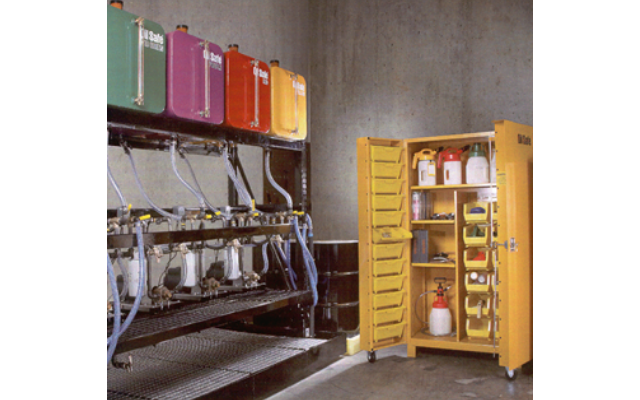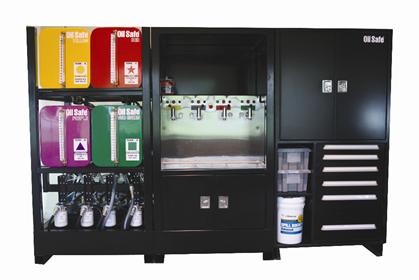Author: Heinz P. Bloch, P.E.
Before reading the article below, Read Part 1 and Part 2 of this 3-part series.
Open and up-turned vents in storage barrels invite entry of both moisture and particulate contamination. Each drum may contain $1,200 worth of synthetic lubricant that is now rendered unserviceable. One solution is shown in Fig. 1 where outdoor drum storage has been replaced by indoor mini-bulk storage in sheltered or similarly protected locations. Bulk tanks and drums are placed under cover.
Contamination control of bulk storage containers makes it highly desirable to put oil drums indoors. In the event that outdoor storage is chosen, the storage area must be covered by a suitable roof and side panels to ward off direct rain and snow.
Largely self-contained lubrication work centers (Fig. 2) are available for clean oil storage and oil dispensing. These also merit serious consideration (Ref. 1). They replace traditional storage in cumbersome and generally inefficient 55 gallon drums. Modern lubrication work centers incorporate an interchangeable series of frames, pumps, filters and storage modules. There also are spill containment cans and other suitable keep-clean provisions.
The new work centers should be preferred over antiquated tank and drum rack systems. Older systems often pay little attention to contamination avoidance and a facility’s lubrication work flow processes.
Periodic audits
Periodic audits of lubrication practices are performed at leading-edge facilities and many of these lube audits uncover unsatisfactory lubricant dispensing practices. Audit findings and recommendations often involve detection of oil contamination in sump-lubricated equipment and the labeling of points to be lubricated (Ref. 2).
Regrettably, some plants persist in arbitrarily “standardizing” on less than optimum oil and grease formulations. Many are employing incorrect regreasing practices on the millions of electric motors used to drive process pumps. Superior plants experience as few as 14 motor bearing replacements per 1,000 motors per year; average plants replace 156 motor bearing replacements per 1,000 motors per year (Ref. 3). The statistics of less-than-average plants are far worse.
Suffice it to say that being unaware of best available lubrication management and practices can be very expensive. These expenditures could be avoided by simply keeping out contaminants. Experience shows that periodic lube management audits are cost-effective and almost always point out areas of improvement (Ref. 3).
What we have learned
- Correct outdoor storage of oil drums involves considerable forethought and constant attention.
- Storage under a shelter or indoor storage is much preferred over full exposure to the ambient environment.
- Water and particulate contaminants can greatly impair bearing life. They must be kept away from pump bearings.
- Drum vent provisions are needed, but open vents that allow water and dirt ingress are unacceptable.
- Transfer containers should be purposefully designed and be kept immaculately clean.
- Periodic lube management audits are recommended.
References
- Fluid Defense Systems, Montgomery, Illinois 60538
- Bloch, Heinz P.; “Petrochemical Machinery Insights” (2017) Elsevier Publishing, Oxford, UK and Cambridge, MA; ISBN 978-0-12-809272-9
- Bloch, Heinz P.; “Machinery Reliability Improvement", 3rd Edition (1998) Gulf Publishing Company, Houston, Texas; ISBN 0-88415-661-3






Comments